1993 FORD MONDEO wheel bolt torque
[x] Cancel search: wheel bolt torquePage 80 of 279
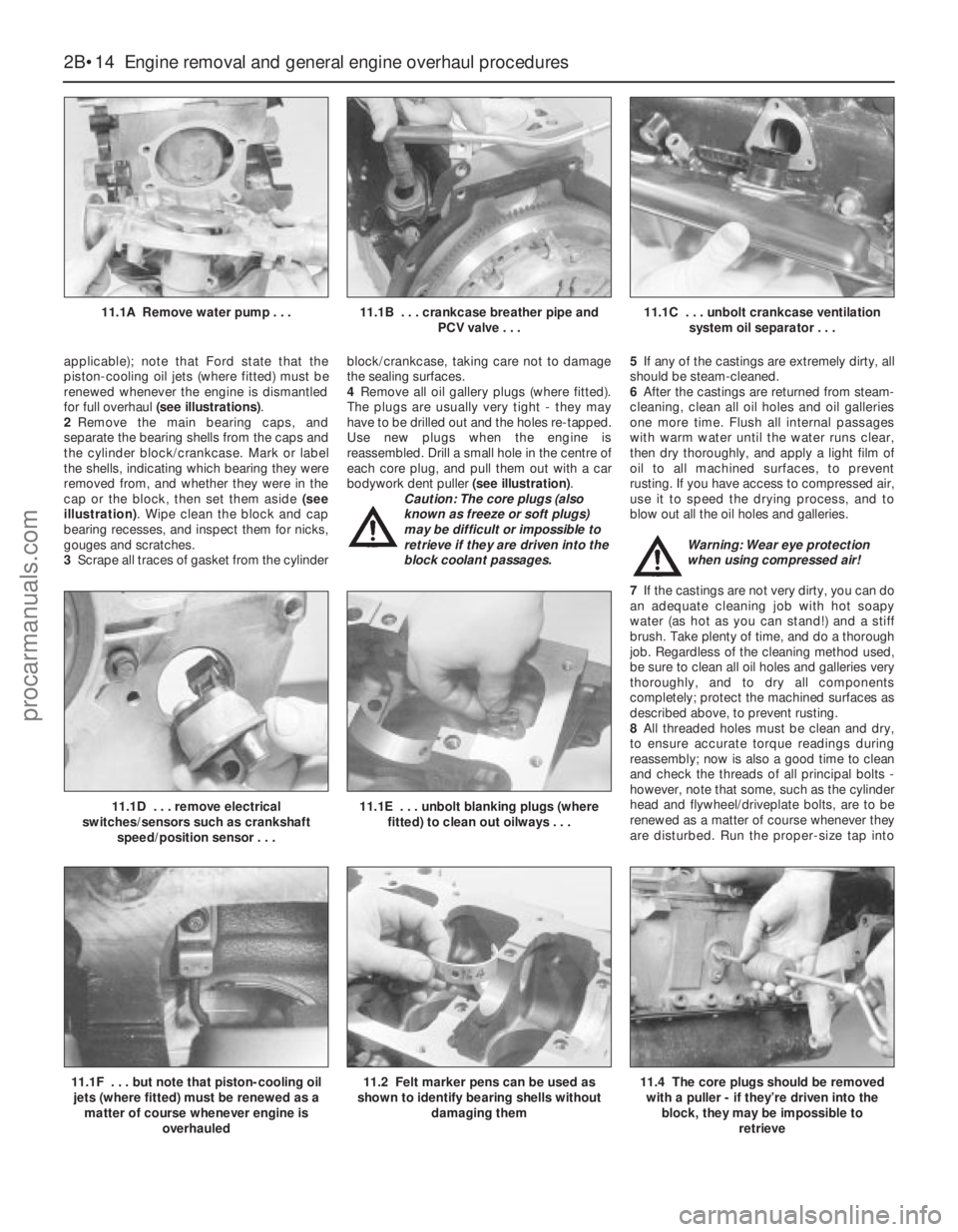
applicable); note that Ford state that the
piston-cooling oil jets (where fitted) must be
renewed whenever the engine is dismantled
for full overhaul (see illustrations).
2Remove the main bearing caps, and
separate the bearing shells from the caps and
the cylinder block/crankcase. Mark or label
the shells, indicating which bearing they were
removed from, and whether they were in the
cap or the block, then set them aside (see
illustration). Wipe clean the block and cap
bearing recesses, and inspect them for nicks,
gouges and scratches.
3Scrape all traces of gasket from the cylinderblock/crankcase, taking care not to damage
the sealing surfaces.
4Remove all oil gallery plugs (where fitted).
The plugs are usually very tight - they may
have to be drilled out and the holes re-tapped.
Use new plugs when the engine is
reassembled. Drill a small hole in the centre of
each core plug, and pull them out with a car
bodywork dent puller (see illustration).
Caution: The core plugs (also
known as freeze or soft plugs)
may be difficult or impossible to
retrieve if they are driven into the
block coolant passages.5If any of the castings are extremely dirty, all
should be steam-cleaned.
6After the castings are returned from steam-
cleaning, clean all oil holes and oil galleries
one more time. Flush all internal passages
with warm water until the water runs clear,
then dry thoroughly, and apply a light film of
oil to all machined surfaces, to prevent
rusting. If you have access to compressed air,
use it to speed the drying process, and to
blow out all the oil holes and galleries.
Warning: Wear eye protection
when using compressed air!
7If the castings are not very dirty, you can do
an adequate cleaning job with hot soapy
water (as hot as you can stand!) and a stiff
brush. Take plenty of time, and do a thorough
job. Regardless of the cleaning method used,
be sure to clean all oil holes and galleries very
thoroughly, and to dry all components
completely; protect the machined surfaces as
described above, to prevent rusting.
8All threaded holes must be clean and dry,
to ensure accurate torque readings during
reassembly; now is also a good time to clean
and check the threads of all principal bolts -
however, note that some, such as the cylinder
head and flywheel/driveplate bolts, are to be
renewed as a matter of course whenever they
are disturbed. Run the proper-size tap into
2B•14 Engine removal and general engine overhaul procedures
11.1A Remove water pump . . .11.1B . . . crankcase breather pipe and
PCV valve . . .11.1C . . . unbolt crankcase ventilation
system oil separator . . .
11.1F . . . but note that piston-cooling oil
jets (where fitted) must be renewed as a
matter of course whenever engine is
overhauled11.2 Felt marker pens can be used as
shown to identify bearing shells without
damaging them
11.1D . . . remove electrical
switches/sensors such as crankshaft
speed/position sensor . . .11.1E . . . unbolt blanking plugs (where
fitted) to clean out oilways . . .
11.4 The core plugs should be removed
with a puller - if they’re driven into the
block, they may be impossible to
retrieve
procarmanuals.com
Page 117 of 279
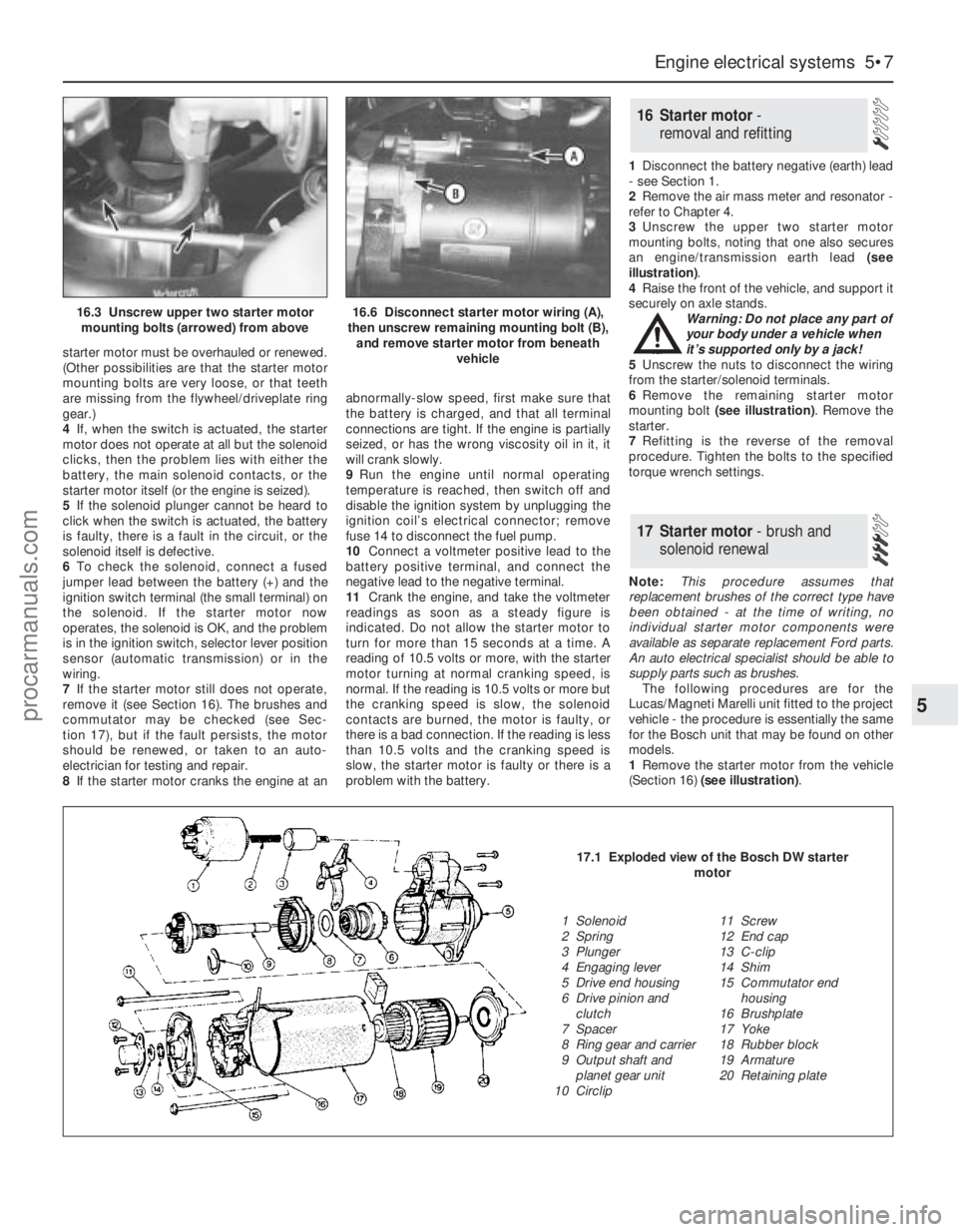
starter motor must be overhauled or renewed.
(Other possibilities are that the starter motor
mounting bolts are very loose, or that teeth
are missing from the flywheel/driveplate ring
gear.)
4If, when the switch is actuated, the starter
motor does not operate at all but the solenoid
clicks, then the problem lies with either the
battery, the main solenoid contacts, or the
starter motor itself (or the engine is seized).
5If the solenoid plunger cannot be heard to
click when the switch is actuated, the battery
is faulty, there is a fault in the circuit, or the
solenoid itself is defective.
6To check the solenoid, connect a fused
jumper lead between the battery (+) and the
ignition switch terminal (the small terminal) on
the solenoid. If the starter motor now
operates, the solenoid is OK, and the problem
is in the ignition switch, selector lever position
sensor (automatic transmission) or in the
wiring.
7If the starter motor still does not operate,
remove it (see Section 16). The brushes and
commutator may be checked (see Sec-
tion 17), but if the fault persists, the motor
should be renewed, or taken to an auto-
electrician for testing and repair.
8If the starter motor cranks the engine at anabnormally-slow speed, first make sure that
the battery is charged, and that all terminal
connections are tight. If the engine is partially
seized, or has the wrong viscosity oil in it, it
will crank slowly.
9Run the engine until normal operating
temperature is reached, then switch off and
disable the ignition system by unplugging the
ignition coil’s electrical connector; remove
fuse 14 to disconnect the fuel pump.
10Connect a voltmeter positive lead to the
battery positive terminal, and connect the
negative lead to the negative terminal.
11Crank the engine, and take the voltmeter
readings as soon as a steady figure is
indicated. Do not allow the starter motor to
turn for more than 15 seconds at a time. A
reading of 10.5 volts or more, with the starter
motor turning at normal cranking speed, is
normal. If the reading is 10.5 volts or more but
the cranking speed is slow, the solenoid
contacts are burned, the motor is faulty, or
there is a bad connection. If the reading is less
than 10.5 volts and the cranking speed is
slow, the starter motor is faulty or there is a
problem with the battery.1Disconnect the battery negative (earth) lead
- see Section 1.
2Remove the air mass meter and resonator -
refer to Chapter 4.
3Unscrew the upper two starter motor
mounting bolts, noting that one also secures
an engine/transmission earth lead (see
illustration).
4Raise the front of the vehicle, and support it
securely on axle stands.
Warning: Do not place any part of
your body under a vehicle when
it’s supported only by a jack!
5Unscrew the nuts to disconnect the wiring
from the starter/solenoid terminals.
6Remove the remaining starter motor
mounting bolt (see illustration). Remove the
starter.
7Refitting is the reverse of the removal
procedure. Tighten the bolts to the specified
torque wrench settings.
Note:This procedure assumes that
replacement brushes of the correct type have
been obtained - at the time of writing, no
individual starter motor components were
available as separate replacement Ford parts.
An auto electrical specialist should be able to
supply parts such as brushes.
The following procedures are for the
Lucas/Magneti Marelli unit fitted to the project
vehicle - the procedure is essentially the same
for the Bosch unit that may be found on other
models.
1Remove the starter motor from the vehicle
(Section 16) (see illustration).
17 Starter motor- brush and
solenoid renewal
16 Starter motor -
removal and refitting
Engine electrical systems 5•7
5
16.3 Unscrew upper two starter motor
mounting bolts (arrowed) from above16.6 Disconnect starter motor wiring (A),
then unscrew remaining mounting bolt (B),
and remove starter motor from beneath
vehicle
17.1 Exploded view of the Bosch DW starter
motor
1 Solenoid
2 Spring
3 Plunger
4 Engaging lever
5 Drive end housing
6 Drive pinion and
clutch
7 Spacer
8 Ring gear and carrier
9 Output shaft and
planet gear unit
10 Circlip11 Screw
12 End cap
13 C-clip
14 Shim
15 Commutator end
housing
16 Brushplate
17 Yoke
18 Rubber block
19 Armature
20 Retaining plate
procarmanuals.com
Page 120 of 279

Torque wrench settingsNm lbf ft
Front caliper bracket . . . . . . . . . . . . . . . . . . . . . . . . . . . . . . . . . . . . . . . . 120 89
Rear caliper bracket . . . . . . . . . . . . . . . . . . . . . . . . . . . . . . . . . . . . . . . . 59 44
Front caliper guide bolts . . . . . . . . . . . . . . . . . . . . . . . . . . . . . . . . . . . . . 28 21
Rear caliper guide bolts . . . . . . . . . . . . . . . . . . . . . . . . . . . . . . . . . . . . . 41 30
Rear drum brake backplate . . . . . . . . . . . . . . . . . . . . . . . . . . . . . . . . . . . 50 37
Vacuum servo unit . . . . . . . . . . . . . . . . . . . . . . . . . . . . . . . . . . . . . . . . . 40 30
Master cylinder . . . . . . . . . . . . . . . . . . . . . . . . . . . . . . . . . . . . . . . . . . . . 23 17
ABS hydraulic unit to bracket . . . . . . . . . . . . . . . . . . . . . . . . . . . . . . . . . 20 15
Roadwheel nuts . . . . . . . . . . . . . . . . . . . . . . . . . . . . . . . . . . . . . . . . . . . 85 63
9•2 Braking system
1.2 Handbrake lever and associated components
1 Handbrake lever
2 Clock spring
3 Handbrake cable
4 Toothed segment and pawl to lock the
handbrake lever5 Fine-toothed segment for the clock spring
6 Pawl for the clock spring
7 Underbody bracket
The braking system is of diagonally-split,
dual-circuit design, with ventilated discs at
the front, and drum or disc brakes (according
to model) at the rear. The front calipers are of
floating single-piston design, using asbestos-
free pads. The rear drum brakes are of the
leading and trailing shoe type. They are self-
adjusting during footbrake operation. The rear
brake shoe linings are of different
thicknesses, in order to allow for the different
proportional rates of wear.
Pressure-control relief (PCR) valves are
fitted to the rear brakes, to prevent rear wheel
lock-up under hard braking. The valves are
sometimes referred to as pressure-conscious
reducing valves. On non-ABS models, theyare fitted in the master cylinder rear brake
outlet ports; on ABS models, they are located
on the ABS unit.
When rear disc brakes are fitted, the rear
brake caliper is located on the front of the
knuckle on Saloon and Hatchback models,
and on the rear of the knuckle on Estate
models (see illustration).
The handbrake is cable-operated, and acts
on the rear brakes. On rear drum brake
models, the cables operate on the rear trailing
brake shoe operating levers, and on rear disc
brake models, they operate on levers on the
rear calipers. The handbrake lever
incorporates an automatic adjuster, which
removes any slack from the cables when the
lever is disengaged (see illustration).
Handbrake lever movement remains
consistent at all times, and no adjustment is
necessary or possible.
Where fitted, the anti-lock braking system
(ABS) is of the four-channel low-pressure type
(see illustration). It uses the basic
conventional brake system, together with aBendix ABS hydraulic unit fitted between the
master cylinder and the four wheel brakes.
The hydraulic unit consists of a hydraulic
actuator, an ABS brake pressure pump, an
ABS module with built-in relay box, and two
pressure-control relief valves. Braking at each
of the four wheels is controlled by separate
solenoid valves in the hydraulic actuator. If
wheel lock-up is detected on a wheel when
the vehicle speed is above 3 mph, the valve
opens, releasing pressure to the relevant
brake, until the wheel regains a rotational
speed corresponding to the speed of the
vehicle. The cycle can be repeated many
times a second. In the event of a fault in the
ABS system, the conventional braking system
is not affected. Diagnosis of a fault in the ABS
system requires the use of special equipment,
and this work should therefore be left to a
Ford dealer. Diagnostic connectors are
located on the side of the left-hand front
suspension turret.
The traction control system (TCS) is fitted
as an option to some models, and uses the
1 General information
1.1 Rear disc brake location on
Saloon/Hatchback models (A) and Estate
models (B)
1 Handbrake cable lever facing away from
caliper
2 Handbrake cable lever facing towards
caliper
3 Brake hose banjo bolt
4 Front of vehicle
procarmanuals.com
Page 122 of 279
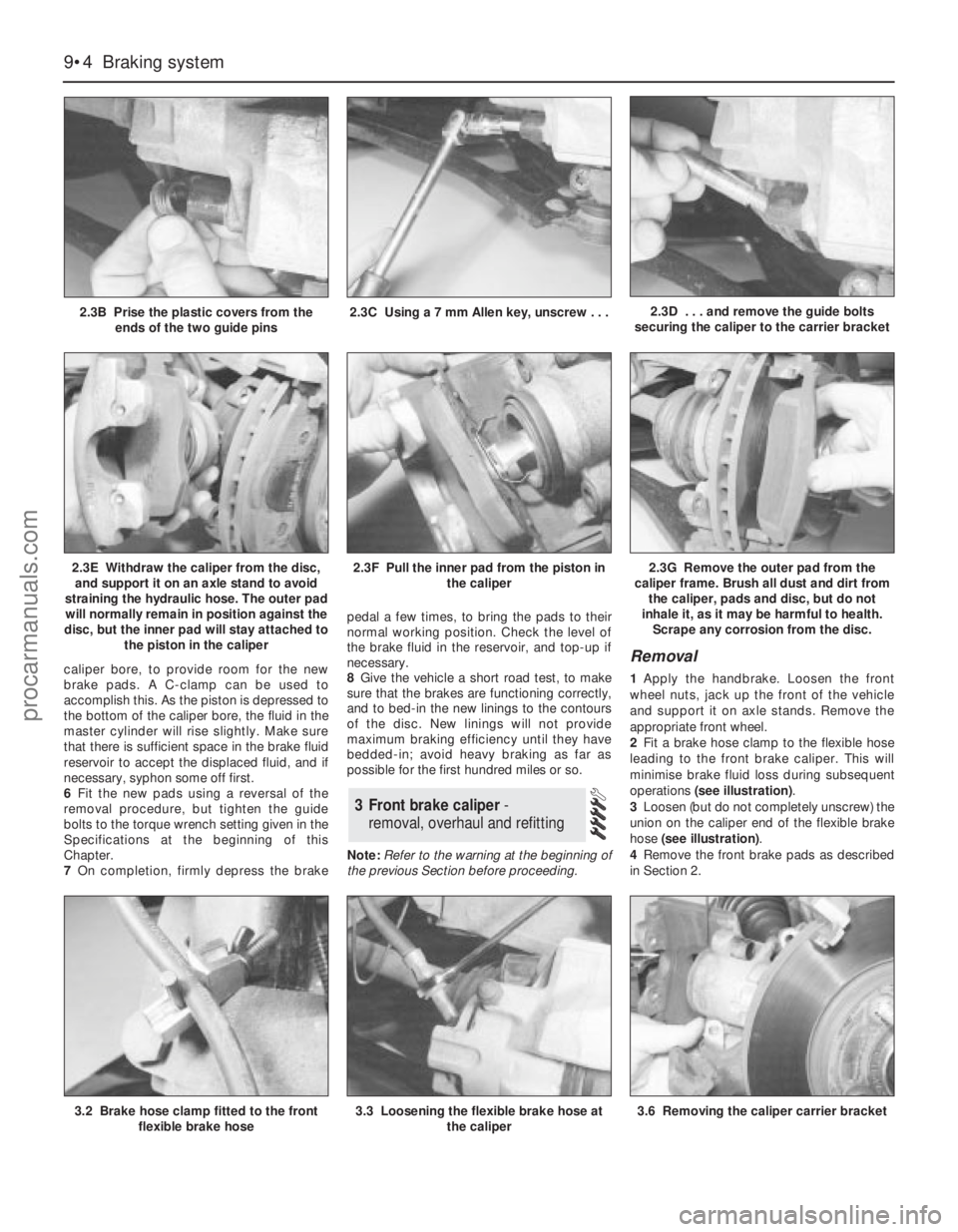
caliper bore, to provide room for the new
brake pads. A C-clamp can be used to
accomplish this. As the piston is depressed to
the bottom of the caliper bore, the fluid in the
master cylinder will rise slightly. Make sure
that there is sufficient space in the brake fluid
reservoir to accept the displaced fluid, and if
necessary, syphon some off first.
6Fit the new pads using a reversal of the
removal procedure, but tighten the guide
bolts to the torque wrench setting given in the
Specifications at the beginning of this
Chapter.
7On completion, firmly depress the brakepedal a few times, to bring the pads to their
normal working position. Check the level of
the brake fluid in the reservoir, and top-up if
necessary.
8Give the vehicle a short road test, to make
sure that the brakes are functioning correctly,
and to bed-in the new linings to the contours
of the disc. New linings will not provide
maximum braking efficiency until they have
bedded-in; avoid heavy braking as far as
possible for the first hundred miles or so.
Note:Refer to the warning at the beginning of
the previous Section before proceeding.Removal
1Apply the handbrake. Loosen the front
wheel nuts, jack up the front of the vehicle
and support it on axle stands. Remove the
appropriate front wheel.
2Fit a brake hose clamp to the flexible hose
leading to the front brake caliper. This will
minimise brake fluid loss during subsequent
operations (see illustration).
3Loosen (but do not completely unscrew) the
union on the caliper end of the flexible brake
hose (see illustration).
4Remove the front brake pads as described
in Section 2.
3 Front brake caliper -
removal, overhaul and refitting
9•4 Braking system
2.3B Prise the plastic covers from the
ends of the two guide pins2.3C Using a 7 mm Allen key, unscrew . . .2.3D . . . and remove the guide bolts
securing the caliper to the carrier bracket
2.3E Withdraw the caliper from the disc,
and support it on an axle stand to avoid
straining the hydraulic hose. The outer pad
will normally remain in position against the
disc, but the inner pad will stay attached to
the piston in the caliper2.3F Pull the inner pad from the piston in
the caliper
3.2 Brake hose clamp fitted to the front
flexible brake hose3.3 Loosening the flexible brake hose at
the caliper3.6 Removing the caliper carrier bracket
2.3G Remove the outer pad from the
caliper frame. Brush all dust and dirt from
the caliper, pads and disc, but do not
inhale it, as it may be harmful to health.
Scrape any corrosion from the disc.
procarmanuals.com
Page 123 of 279
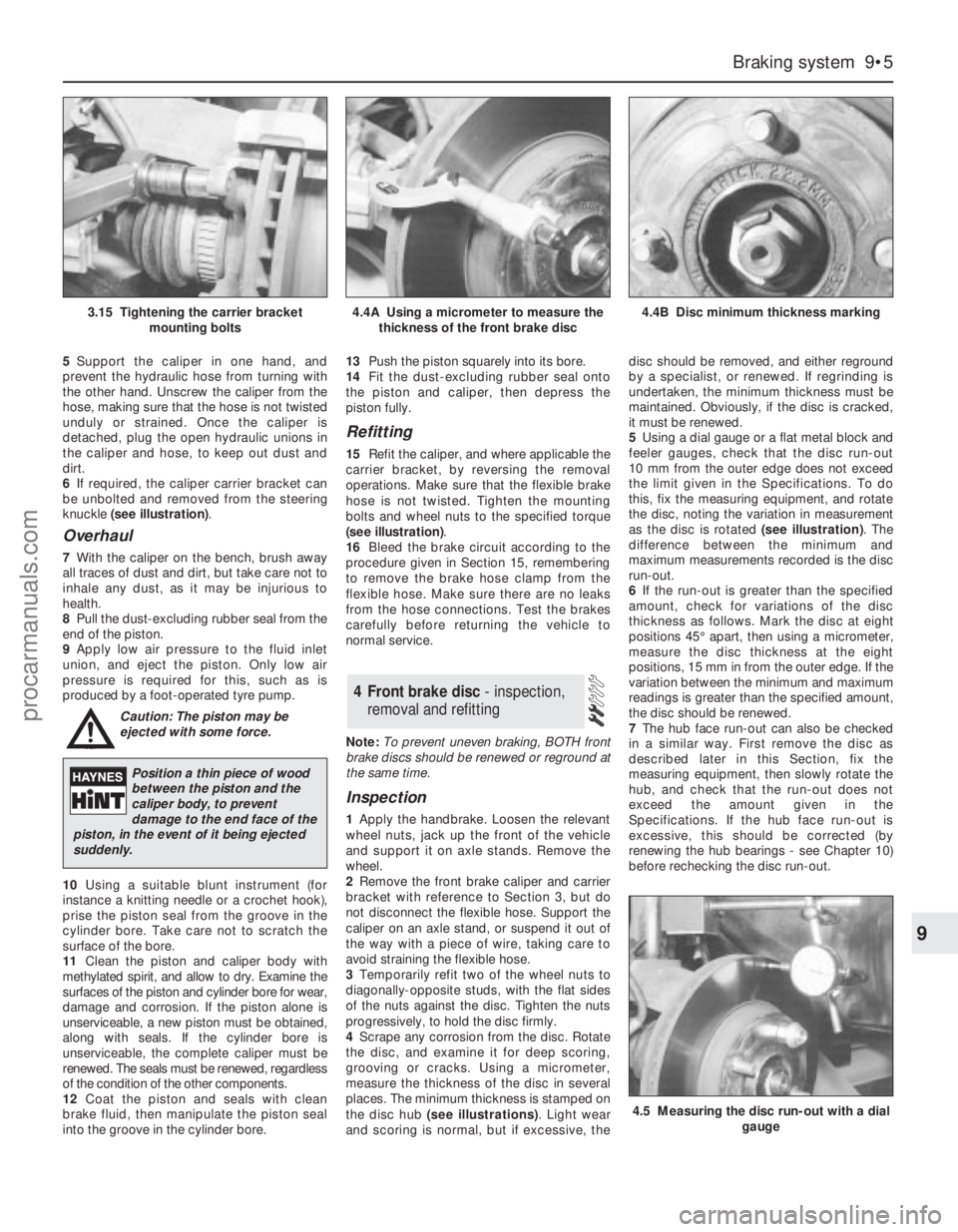
5Support the caliper in one hand, and
prevent the hydraulic hose from turning with
the other hand. Unscrew the caliper from the
hose, making sure that the hose is not twisted
unduly or strained. Once the caliper is
detached, plug the open hydraulic unions in
the caliper and hose, to keep out dust and
dirt.
6If required, the caliper carrier bracket can
be unbolted and removed from the steering
knuckle (see illustration).
Overhaul
7With the caliper on the bench, brush away
all traces of dust and dirt, but take care not to
inhale any dust, as it may be injurious to
health.
8Pull the dust-excluding rubber seal from the
end of the piston.
9Apply low air pressure to the fluid inlet
union, and eject the piston. Only low air
pressure is required for this, such as is
produced by a foot-operated tyre pump.
Caution: The piston may be
ejected with some force.
10Using a suitable blunt instrument (for
instance a knitting needle or a crochet hook),
prise the piston seal from the groove in the
cylinder bore. Take care not to scratch the
surface of the bore.
11Clean the piston and caliper body with
methylated spirit, and allow to dry. Examine the
surfaces of the piston and cylinder bore for wear,
damage and corrosion. If the piston alone is
unserviceable, a new piston must be obtained,
along with seals. If the cylinder bore is
unserviceable, the complete caliper must be
renewed. The seals must be renewed, regardless
of the condition of the other components.
12Coat the piston and seals with clean
brake fluid, then manipulate the piston seal
into the groove in the cylinder bore.13Push the piston squarely into its bore.
14Fit the dust-excluding rubber seal onto
the piston and caliper, then depress the
piston fully.
Refitting
15Refit the caliper, and where applicable the
carrier bracket, by reversing the removal
operations. Make sure that the flexible brake
hose is not twisted. Tighten the mounting
bolts and wheel nuts to the specified torque
(see illustration).
16Bleed the brake circuit according to the
procedure given in Section 15, remembering
to remove the brake hose clamp from the
flexible hose. Make sure there are no leaks
from the hose connections. Test the brakes
carefully before returning the vehicle to
normal service.
Note:To prevent uneven braking, BOTH front
brake discs should be renewed or reground at
the same time.
Inspection
1Apply the handbrake. Loosen the relevant
wheel nuts, jack up the front of the vehicle
and support it on axle stands. Remove the
wheel.
2Remove the front brake caliper and carrier
bracket with reference to Section 3, but do
not disconnect the flexible hose. Support the
caliper on an axle stand, or suspend it out of
the way with a piece of wire, taking care to
avoid straining the flexible hose.
3Temporarily refit two of the wheel nuts to
diagonally-opposite studs, with the flat sides
of the nuts against the disc. Tighten the nuts
progressively, to hold the disc firmly.
4Scrape any corrosion from the disc. Rotate
the disc, and examine it for deep scoring,
grooving or cracks. Using a micrometer,
measure the thickness of the disc in several
places. The minimum thickness is stamped on
the disc hub (see illustrations). Light wear
and scoring is normal, but if excessive, thedisc should be removed, and either reground
by a specialist, or renewed. If regrinding is
undertaken, the minimum thickness must be
maintained. Obviously, if the disc is cracked,
it must be renewed.
5Using a dial gauge or a flat metal block and
feeler gauges, check that the disc run-out
10 mm from the outer edge does not exceed
the limit given in the Specifications. To do
this, fix the measuring equipment, and rotate
the disc, noting the variation in measurement
as the disc is rotated (see illustration). The
difference between the minimum and
maximum measurements recorded is the disc
run-out.
6If the run-out is greater than the specified
amount, check for variations of the disc
thickness as follows. Mark the disc at eight
positions 45° apart, then using a micrometer,
measure the disc thickness at the eight
positions, 15 mm in from the outer edge. If the
variation between the minimum and maximum
readings is greater than the specified amount,
the disc should be renewed.
7The hub face run-out can also be checked
in a similar way. First remove the disc as
described later in this Section, fix the
measuring equipment, then slowly rotate the
hub, and check that the run-out does not
exceed the amount given in the
Specifications. If the hub face run-out is
excessive, this should be corrected (by
renewing the hub bearings - see Chapter 10)
before rechecking the disc run-out.
4 Front brake disc - inspection,
removal and refitting
Braking system 9•5
9
4.5 Measuring the disc run-out with a dial
gauge
3.15 Tightening the carrier bracket
mounting bolts4.4A Using a micrometer to measure the
thickness of the front brake disc4.4B Disc minimum thickness marking
Position a thin piece of wood
between the piston and the
caliper body, to prevent
damage to the end face of the
piston, in the event of it being ejected
suddenly.
procarmanuals.com
Page 127 of 279
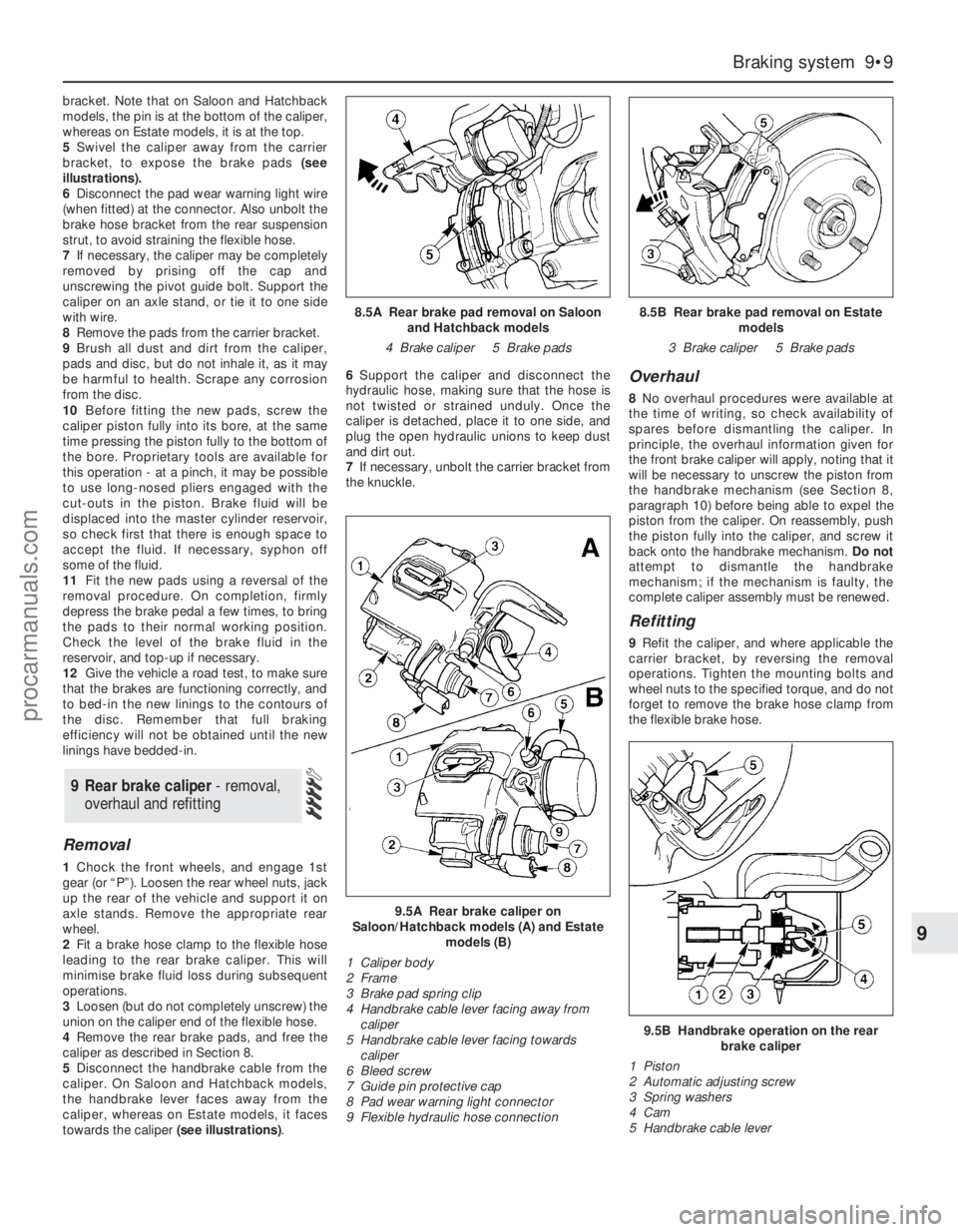
bracket. Note that on Saloon and Hatchback
models, the pin is at the bottom of the caliper,
whereas on Estate models, it is at the top.
5Swivel the caliper away from the carrier
bracket, to expose the brake pads (see
illustrations).
6Disconnect the pad wear warning light wire
(when fitted) at the connector. Also unbolt the
brake hose bracket from the rear suspension
strut, to avoid straining the flexible hose.
7If necessary, the caliper may be completely
removed by prising off the cap and
unscrewing the pivot guide bolt. Support the
caliper on an axle stand, or tie it to one side
with wire.
8Remove the pads from the carrier bracket.
9Brush all dust and dirt from the caliper,
pads and disc, but do not inhale it, as it may
be harmful to health. Scrape any corrosion
from the disc.
10Before fitting the new pads, screw the
caliper piston fully into its bore, at the same
time pressing the piston fully to the bottom of
the bore. Proprietary tools are available for
this operation - at a pinch, it may be possible
to use long-nosed pliers engaged with the
cut-outs in the piston. Brake fluid will be
displaced into the master cylinder reservoir,
so check first that there is enough space to
accept the fluid. If necessary, syphon off
some of the fluid.
11Fit the new pads using a reversal of the
removal procedure. On completion, firmly
depress the brake pedal a few times, to bring
the pads to their normal working position.
Check the level of the brake fluid in the
reservoir, and top-up if necessary.
12Give the vehicle a road test, to make sure
that the brakes are functioning correctly, and
to bed-in the new linings to the contours of
the disc. Remember that full braking
efficiency will not be obtained until the new
linings have bedded-in.
Removal
1Chock the front wheels, and engage 1st
gear (or “P”). Loosen the rear wheel nuts, jack
up the rear of the vehicle and support it on
axle stands. Remove the appropriate rear
wheel.
2Fit a brake hose clamp to the flexible hose
leading to the rear brake caliper. This will
minimise brake fluid loss during subsequent
operations.
3Loosen (but do not completely unscrew) the
union on the caliper end of the flexible hose.
4Remove the rear brake pads, and free the
caliper as described in Section 8.
5Disconnect the handbrake cable from the
caliper. On Saloon and Hatchback models,
the handbrake lever faces away from the
caliper, whereas on Estate models, it faces
towards the caliper (see illustrations).6Support the caliper and disconnect the
hydraulic hose, making sure that the hose is
not twisted or strained unduly. Once the
caliper is detached, place it to one side, and
plug the open hydraulic unions to keep dust
and dirt out.
7If necessary, unbolt the carrier bracket from
the knuckle.
Overhaul
8No overhaul procedures were available at
the time of writing, so check availability of
spares before dismantling the caliper. In
principle, the overhaul information given for
the front brake caliper will apply, noting that it
will be necessary to unscrew the piston from
the handbrake mechanism (see Section 8,
paragraph 10) before being able to expel the
piston from the caliper. On reassembly, push
the piston fully into the caliper, and screw it
back onto the handbrake mechanism. Do not
attempt to dismantle the handbrake
mechanism; if the mechanism is faulty, the
complete caliper assembly must be renewed.
Refitting
9Refit the caliper, and where applicable the
carrier bracket, by reversing the removal
operations. Tighten the mounting bolts and
wheel nuts to the specified torque, and do not
forget to remove the brake hose clamp from
the flexible brake hose.
9 Rear brake caliper - removal,
overhaul and refitting
Braking system 9•9
9
9.5A Rear brake caliper on
Saloon/Hatchback models (A) and Estate
models (B)
1 Caliper body
2 Frame
3 Brake pad spring clip
4 Handbrake cable lever facing away from
caliper
5 Handbrake cable lever facing towards
caliper
6 Bleed screw
7 Guide pin protective cap
8 Pad wear warning light connector
9 Flexible hydraulic hose connection
9.5B Handbrake operation on the rear
brake caliper
1 Piston
2 Automatic adjusting screw
3 Spring washers
4 Cam
5 Handbrake cable lever
8.5A Rear brake pad removal on Saloon
and Hatchback models
4 Brake caliper 5 Brake pads8.5B Rear brake pad removal on Estate
models
3 Brake caliper 5 Brake pads
procarmanuals.com
Page 148 of 279
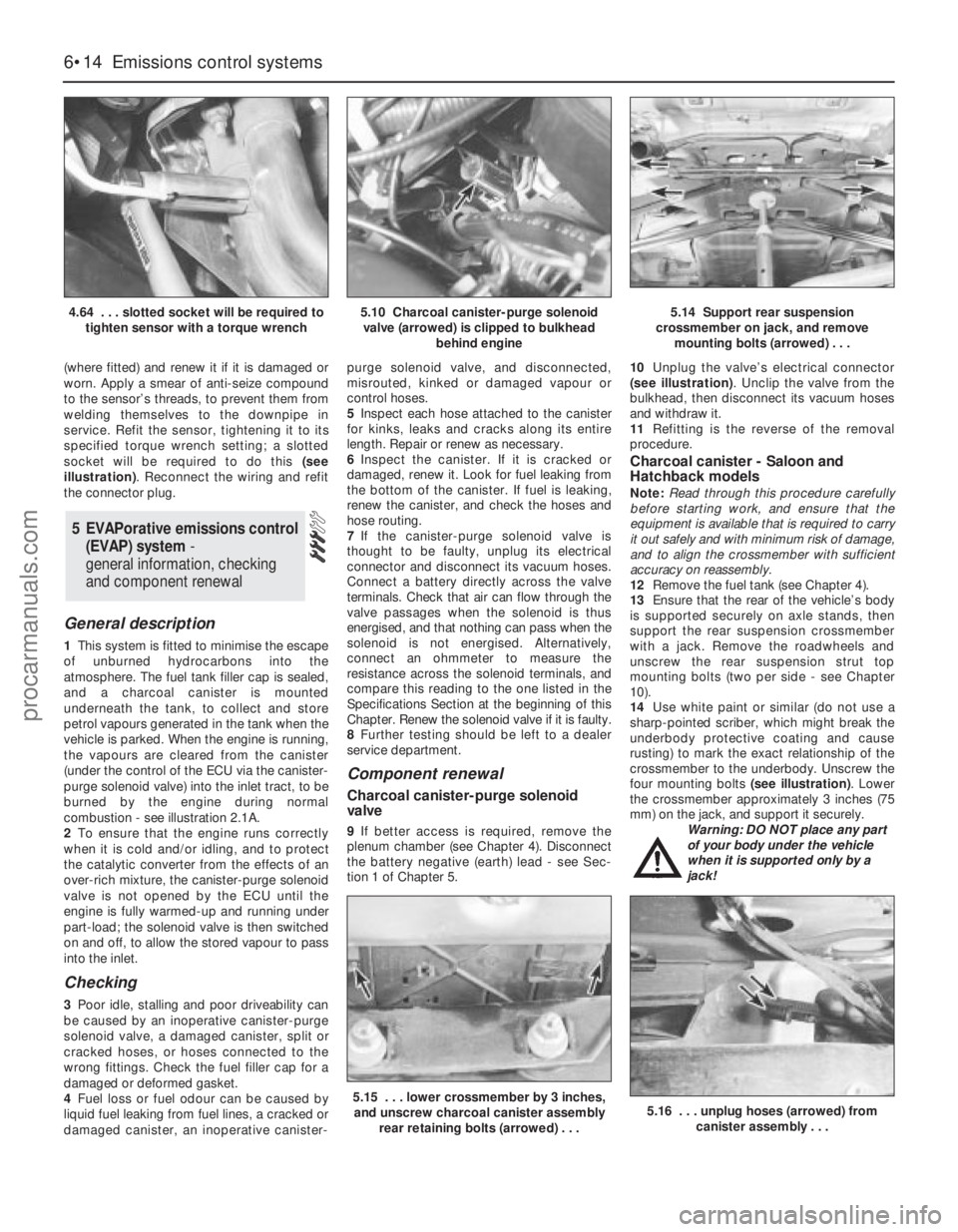
(where fitted) and renew it if it is damaged or
worn. Apply a smear of anti-seize compound
to the sensor’s threads, to prevent them from
welding themselves to the downpipe in
service. Refit the sensor, tightening it to its
specified torque wrench setting; a slotted
socket will be required to do this (see
illustration). Reconnect the wiring and refit
the connector plug.
General description
1This system is fitted to minimise the escape
of unburned hydrocarbons into the
atmosphere. The fuel tank filler cap is sealed,
and a charcoal canister is mounted
underneath the tank, to collect and store
petrol vapours generated in the tank when the
vehicle is parked. When the engine is running,
the vapours are cleared from the canister
(under the control of the ECU via the canister-
purge solenoid valve) into the inlet tract, to be
burned by the engine during normal
combustion - see illustration 2.1A.
2To ensure that the engine runs correctly
when it is cold and/or idling, and to protect
the catalytic converter from the effects of an
over-rich mixture, the canister-purge solenoid
valve is not opened by the ECU until the
engine is fully warmed-up and running under
part-load; the solenoid valve is then switched
on and off, to allow the stored vapour to pass
into the inlet.
Checking
3Poor idle, stalling and poor driveability can
be caused by an inoperative canister-purge
solenoid valve, a damaged canister, split or
cracked hoses, or hoses connected to the
wrong fittings. Check the fuel filler cap for a
damaged or deformed gasket.
4Fuel loss or fuel odour can be caused by
liquid fuel leaking from fuel lines, a cracked or
damaged canister, an inoperative canister-purge solenoid valve, and disconnected,
misrouted, kinked or damaged vapour or
control hoses.
5Inspect each hose attached to the canister
for kinks, leaks and cracks along its entire
length. Repair or renew as necessary.
6Inspect the canister. If it is cracked or
damaged, renew it. Look for fuel leaking from
the bottom of the canister. If fuel is leaking,
renew the canister, and check the hoses and
hose routing.
7If the canister-purge solenoid valve is
thought to be faulty, unplug its electrical
connector and disconnect its vacuum hoses.
Connect a battery directly across the valve
terminals. Check that air can flow through the
valve passages when the solenoid is thus
energised, and that nothing can pass when the
solenoid is not energised. Alternatively,
connect an ohmmeter to measure the
resistance across the solenoid terminals, and
compare this reading to the one listed in the
Specifications Section at the beginning of this
Chapter. Renew the solenoid valve if it is faulty.
8Further testing should be left to a dealer
service department.
Component renewal
Charcoal canister-purge solenoid
valve
9If better access is required, remove the
plenum chamber (see Chapter 4). Disconnect
the battery negative (earth) lead - see Sec-
tion 1 of Chapter 5.10Unplug the valve’s electrical connector
(see illustration). Unclip the valve from the
bulkhead, then disconnect its vacuum hoses
and withdraw it.
11Refitting is the reverse of the removal
procedure.
Charcoal canister - Saloon and
Hatchback models
Note:Read through this procedure carefully
before starting work, and ensure that the
equipment is available that is required to carry
it out safely and with minimum risk of damage,
and to align the crossmember with sufficient
accuracy on reassembly.
12Remove the fuel tank (see Chapter 4).
13Ensure that the rear of the vehicle’s body
is supported securely on axle stands, then
support the rear suspension crossmember
with a jack. Remove the roadwheels and
unscrew the rear suspension strut top
mounting bolts (two per side - see Chapter
10).
14Use white paint or similar (do not use a
sharp-pointed scriber, which might break the
underbody protective coating and cause
rusting) to mark the exact relationship of the
crossmember to the underbody. Unscrew the
four mounting bolts (see illustration). Lower
the crossmember approximately 3 inches (75
mm) on the jack, and support it securely.
Warning: DO NOT place any part
of your body under the vehicle
when it is supported only by a
jack!
5 EVAPorative emissions control
(EVAP) system -
general information, checking
and component renewal
6•14 Emissions control systems
4.64 . . . slotted socket will be required to
tighten sensor with a torque wrench5.10 Charcoal canister-purge solenoid
valve (arrowed) is clipped to bulkhead
behind engine5.14 Support rear suspension
crossmember on jack, and remove
mounting bolts (arrowed) . . .
5.15 . . . lower crossmember by 3 inches,
and unscrew charcoal canister assembly
rear retaining bolts (arrowed) . . .5.16 . . . unplug hoses (arrowed) from
canister assembly . . .
procarmanuals.com
Page 149 of 279
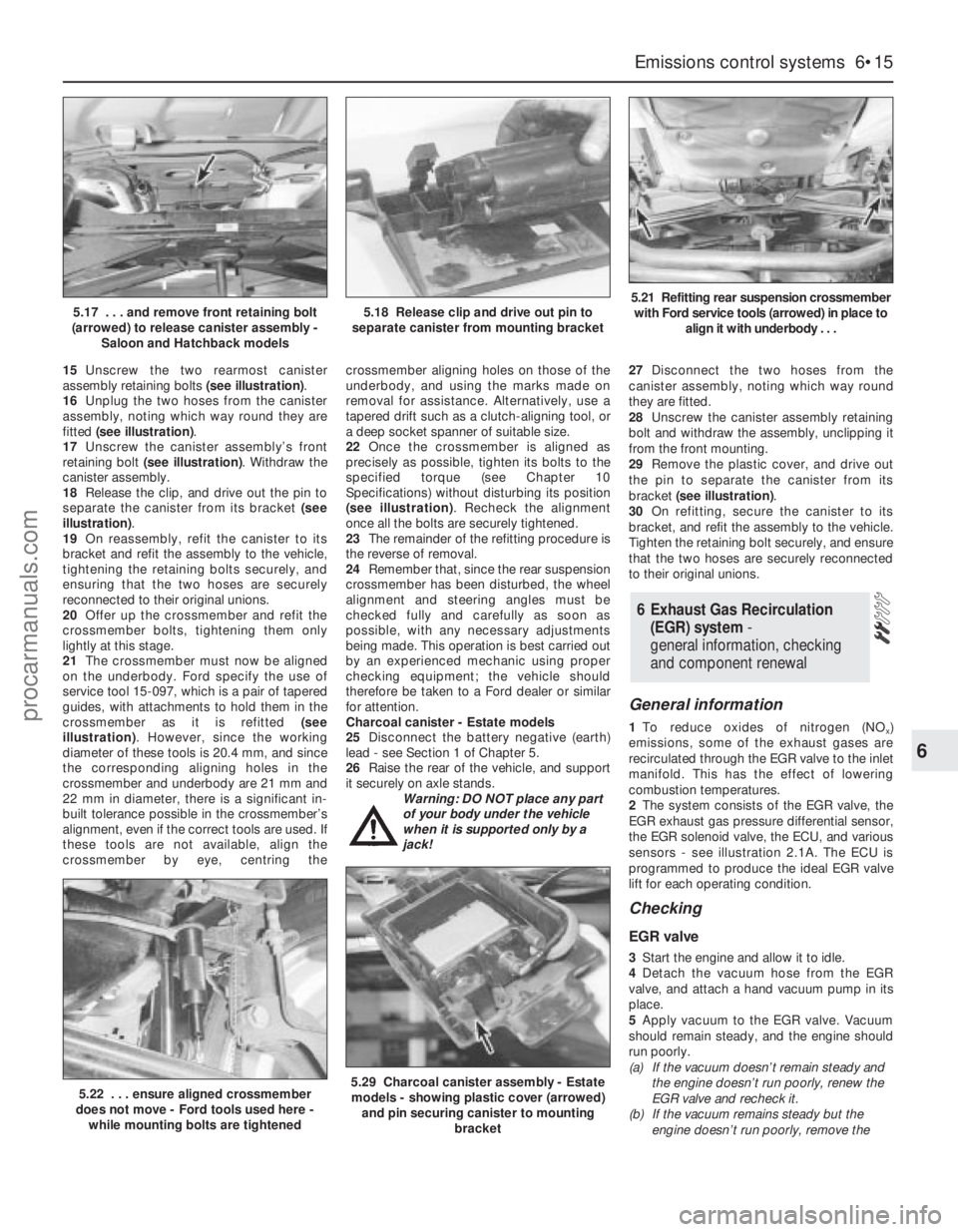
15Unscrew the two rearmost canister
assembly retaining bolts (see illustration).
16Unplug the two hoses from the canister
assembly, noting which way round they are
fitted (see illustration).
17Unscrew the canister assembly’s front
retaining bolt (see illustration). Withdraw the
canister assembly.
18Release the clip, and drive out the pin to
separate the canister from its bracket (see
illustration).
19On reassembly, refit the canister to its
bracket and refit the assembly to the vehicle,
tightening the retaining bolts securely, and
ensuring that the two hoses are securely
reconnected to their original unions.
20Offer up the crossmember and refit the
crossmember bolts, tightening them only
lightly at this stage.
21The crossmember must now be aligned
on the underbody. Ford specify the use of
service tool 15-097, which is a pair of tapered
guides, with attachments to hold them in the
crossmember as it is refitted (see
illustration). However, since the working
diameter of these tools is 20.4 mm, and since
the corresponding aligning holes in the
crossmember and underbody are 21 mm and
22 mm in diameter, there is a significant in-
built tolerance possible in the crossmember’s
alignment, even if the correct tools are used. If
these tools are not available, align the
crossmember by eye, centring thecrossmember aligning holes on those of the
underbody, and using the marks made on
removal for assistance. Alternatively, use a
tapered drift such as a clutch-aligning tool, or
a deep socket spanner of suitable size.
22Once the crossmember is aligned as
precisely as possible, tighten its bolts to the
specified torque (see Chapter 10
Specifications) without disturbing its position
(see illustration). Recheck the alignment
once all the bolts are securely tightened.
23The remainder of the refitting procedure is
the reverse of removal.
24Remember that, since the rear suspension
crossmember has been disturbed, the wheel
alignment and steering angles must be
checked fully and carefully as soon as
possible, with any necessary adjustments
being made. This operation is best carried out
by an experienced mechanic using proper
checking equipment; the vehicle should
therefore be taken to a Ford dealer or similar
for attention.
Charcoal canister - Estate models
25Disconnect the battery negative (earth)
lead - see Section 1 of Chapter 5.
26Raise the rear of the vehicle, and support
it securely on axle stands.
Warning: DO NOT place any part
of your body under the vehicle
when it is supported only by a
jack!27Disconnect the two hoses from the
canister assembly, noting which way round
they are fitted.
28Unscrew the canister assembly retaining
bolt and withdraw the assembly, unclipping it
from the front mounting.
29Remove the plastic cover, and drive out
the pin to separate the canister from its
bracket (see illustration).
30On refitting, secure the canister to its
bracket, and refit the assembly to the vehicle.
Tighten the retaining bolt securely, and ensure
that the two hoses are securely reconnected
to their original unions.
General information
1To reduce oxides of nitrogen (NOx)
emissions, some of the exhaust gases are
recirculated through the EGR valve to the inlet
manifold. This has the effect of lowering
combustion temperatures.
2The system consists of the EGR valve, the
EGR exhaust gas pressure differential sensor,
the EGR solenoid valve, the ECU, and various
sensors - see illustration 2.1A. The ECU is
programmed to produce the ideal EGR valve
lift for each operating condition.
Checking
EGR valve
3Start the engine and allow it to idle.
4Detach the vacuum hose from the EGR
valve, and attach a hand vacuum pump in its
place.
5Apply vacuum to the EGR valve. Vacuum
should remain steady, and the engine should
run poorly.
(a) If the vacuum doesn’t remain steady and
the engine doesn’t run poorly, renew the
EGR valve and recheck it.
(b) If the vacuum remains steady but the
engine doesn’t run poorly, remove the
6 Exhaust Gas Recirculation
(EGR) system-
general information, checking
and component renewal
Emissions control systems 6•15
6
5.22 . . . ensure aligned crossmember
does not move - Ford tools used here -
while mounting bolts are tightened5.29 Charcoal canister assembly - Estate
models - showing plastic cover (arrowed)
and pin securing canister to mounting
bracket
5.17 . . . and remove front retaining bolt
(arrowed) to release canister assembly -
Saloon and Hatchback models5.18 Release clip and drive out pin to
separate canister from mounting bracket5.21 Refitting rear suspension crossmember
with Ford service tools (arrowed) in place to
align it with underbody . . .
procarmanuals.com